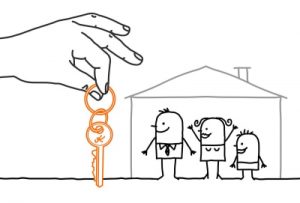Get a Home Insurance quote now. Start saving.

Questions around who’s really entitled to the rebate, how it’s calculated and “am I susceptible to having to pay it back” are often high up new homebuyer’s minds. And for good reason. Losing out on the rebate can make a huge difference to your bottom line that racks up in the tens of thousands of dollars.
In order to shed some light on the HST rebate on new homes in Ontario, the Toronto-based full-service real estate brokerage TheRedPin, highlighted some key facts about the rebate program.
1. The types of buyers who are eligible to receive the HST rebate
It may surprise some to hear that pre-construction buyers aren’t the only ones who can take advantage of HST rebate in Ontario.
Here’s a quick run-down of buyers who can receive the rebate:
- Pre-construction condo buyers
- Buyers who’ve purchased a newly built, never-lived in residence
- An individual who’s constructed a new home from the ground-up
- Owners who’ve undergone head-to-toe renovations that impact every room in the home, transforming at least 90 per cent of a property’s interiors
2. HST rebate for end-users versus investors
A common misstep that puts many at risk of losing out on the new home HST rebate involves applying for the wrong program. In fact, many new homebuyers don’t even know there are different paths to receiving your taxes back or are ambivalent to the fact.
In total, there are two programs:
- The New Homes Rebate (NHR), which is tailored to end-users (more at CRA information on NHR)
- and the New Residential Rental Property Rebate (NRRPR) made for investors (more at CRA information on NRRPR)
While the two rebates differ, both the NHR and NRRPR require the new home buyer wait at least twelve months before re-selling the property to another person.
End Users (NHR):

Under the NHR, you are entitled to receive the rebate on the condition you will occupy the new home as the principal resident (meaning, you’re living in the new home day-in-and-day-out) for at least the first year. In the majority of cases involving an NHR, you’ll receive the HST rebate right away at the time of purchase from the home builder who’ll claim the rebate on your behalf.
In order to ensure your NHR is safe-and-secure and not at risk of being lost, take note of the following points:
- You must live in the new home as the principal resident for at least the first twelve months. That means you, the owner, need to occupy the property as your main place of residence upon closing
- If you sell the home before the initial twelve months from closing, you must pay the rebate back in full. Only after living in the new home for a year can you re-sell the unit while keeping the HST rebate
- A direct relative can live in the new home as the principal resident in the buyer’s place. However, the rebate is only viable when siblings, spouses/common-law partners and parents/children of the buyer occupies the unit. Aunts, uncles and cousins don’t apply
- Be cautious of who helps on the financing end of the equation. If a distant family member or friend joined in as a co-owner, you may be prone to losing out on the HST rebate
- Buyers who file for the NHR must occupy the unit as the principal resident at closing. If you rent off the unit instead of moving in, you could be liable to paying the rebate back in full. If you’re an investor who plans on renting off the new homes to generate monthly income as a landlord, you must apply for the New Residential Rental Property Rebate (NRRPR)
- In order to reinforce the new home is your principal place of residence, make sure to change your address with CRA as well on all government issued IDs when moving in
Investors (NRRPR):
If you’re a buyer who purchased a new home with no intention of moving in at closing but instead, renting it off as a means to generate monthly income as a landlord – you must file for a New Residential Rental Property Rebate (NRRPR).
To qualify, you’re required to provide a one year residential lease guarantee to prove the newly built residence will be rented to a tenant and not sold during the first 12 months after closing.
In order to ensure your NRRPR is safe-and-secure and not at risk of being lost, take note of the following points:
- If the new homes is flipped at the outset, the HST must be paid in full. You must be a landlord for 12 months before reselling to another buyer
- Unlike an NHR, investors who file for an NRRPR must pay the entire HST upfront and will receive the rebate around two or three months after proof of the lease agreement has been submitted. That means, as an investor, you’re going to need more cash on hand at the time of purchase
- You can apply for the HST rebate up to a maximum of two years after closing. After those two years pass, you’re no longer eligible to receive the rebate
- In the majority of cases, pre-construction condo price lists from major developers already reduced the HST rebate
3. What is the amount of rebate versus the full HST payment?
To answer this, we’ll need to take a few steps back and look into how HST is calculated.
Get a Home Insurance quote now. Start saving.
HST stands for harmonized sales tax and was first implemented by the Canadian Revenue Agency in summer 2010 to combine both the federal (GST) and provincial (PST) taxes into one.
In Ontario, HST adds up to around 13 per cent of a new residence’s purchase price.
So how much of the HST does the rebate on new homes cover?
First-and-foremost it’s critical to understand the rebate doesn’t offset all the HST costs on a new home.
For homes priced under $350,000, you’re entitled to a maximum HST rebate of $30,000. Between $350,000 and $450,000 a sliding scale applies, while properties with price tags above $450,000 – $24,000 is the highest rebate amount permitted.
So, if a pre-construction condo is priced at $500,000, the HST would equal to $65,000. After factoring in the rebate, you’d pay a total of only $41,000 – a savings of $24,000.
Just note, no matter the property’s price, you’ll have to pay a chunk of the taxes out of your own pocket.
4. The CRA’s renewed focus on HST rebates

Between April 2015 and September 2016 alone – the CRA audited over 13,403 files and recovered $210.4 million in owed funds. Much of that money was related to issues around the HST rebate.
If a CRA audit identifies some wrong doing was done, the rebate will be denied and the buyer will be required to pay back the entirety of the HST rebate.
Homeowners looking to recover their rebate after being denied from the CRA can appeal, and in certain situations, the matter will come before the Tax Court of Canada.
If you applied for the HST rebate as a principal resident, it’s critical to take steps that prove – on record – you are actually living/lived in the new home day-in-and-day-out. Make sure to change your address with the CRA as well on all government issued IDs, such as your driver’s license and health card.
For investors who plan on leasing the new home, it’s critical not to claim the rebate as a principal resident and instead apply as a landlord through the New Residential Rental Property Rebate.
*The article is meant to provide some useful insight on the HST rebate program in Ontario. That being said, it isn’t legal advice and doesn’t claim to be. It’s best to always consult with your lawyer and realtor regarding the HST in Ontario and other provinces.

